
The Carolina parakeet, or Carolina conure, is an extinct species of small green neotropical parrot with a bright yellow head, reddish orange face, and pale beak that was native to the Eastern, Midwest, and Plains states of the United States. It was the only indigenous parrot within its range, as well as one of only three parrot species native to the United States. It was called puzzi la née or pot pot chee by the Seminole and kelinky in Chickasaw. Though formerly prevalent within its range, the bird had become rare by the middle of the 19th century. The last confirmed sighting in the wild was of the C. c. ludovicianus subspecies in 1910. The last known specimen, a male named Incas, perished in captivity at the Cincinnati Zoo in 1918, and the species was declared extinct in 1939.

Wolf spiders are members of the family Lycosidae. They are robust and agile hunters with excellent eyesight. They live mostly in solitude, hunt alone, and usually do not spin webs. Some are opportunistic hunters, pouncing upon prey as they find it or chasing it over short distances; others wait for passing prey in or near the mouth of a burrow.

The gray catbird, also spelled grey catbird, is a medium-sized North American and Central American perching bird of the mimid family. It is the only member of the "catbird" genus Dumetella. Like the black catbird, it is among the basal lineages of the Mimidae, probably a closer relative of the Caribbean thrasher and trembler assemblage than of the mockingbirds and Toxostoma thrashers. In some areas it is known as the slate-colored mockingbird.

The white-breasted nuthatch is a species of bird in the nuthatch family Sittidae. It is a medium-sized nuthatch, measuring approximately 15.5 cm (6.1 in) in length. Coloration varies somewhat along the species' range, but the upperparts are light blue-gray, with a black crown and nape in males, while females have a dark gray crown. The underparts are whitish, with a reddish tinge on the lower abdomen. Despite not being closely related, the white-breasted nuthatch and the white wagtail are very similar in plumage. The white-breasted nuthatch is a noisy bird. It has a nasal voice and often utters little cries or vocalizations, often composed of repetitions of small invariant whistles. In summer, it is an exclusively insectivorous bird, consuming a wide range of arthropods, but in winter its diet consists mainly of seeds. The nest is located in the cavity of a tree. The clutch consists of five to nine eggs, incubated for two weeks by the female, who is fed by the male. The two adults then feed the young until they fledge, and for a few weeks after that.

The eastern gray squirrel, also known, particularly outside of North America, as simply the grey squirrel, is a tree squirrel in the genus Sciurus. It is native to eastern North America, where it is the most prodigious and ecologically essential natural forest regenerator. Widely introduced to certain places around the world, the eastern gray squirrel in Europe, in particular, is regarded as an invasive species.

Anolis carolinensis or green anole is a tree-dwelling species of anole lizard native to the southeastern United States and introduced to islands in the Pacific and Caribbean. A small to medium-sized lizard, the green anole is a trunk-crown ecomorph and can change its color to several shades from brown to green.

The southern short-tailed shrew is a gray, short-tailed shrew that inhabits the eastern United States.

Camptonotus is a genus of leaf-rolling crickets in the subfamily Gryllacridinae. It includes the following species are all found in the Americas:
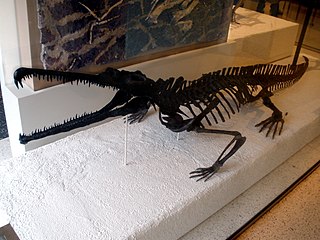
Rutiodon is an extinct genus of mystriosuchine phytosaurs from the Late Triassic of the eastern United States. The type species of Rutiodon, Rutiodon carolinensis, encompasses a large number of skulls and assorted postcranial fossils discovered in the Cumnock Formation of North Carolina. Fossils referable to the species are also known from Pennsylvania, New Jersey, and Virginia. Rutiodon carolinensis is the most well-described species of phytosaur in eastern North America, though its validity as a natural taxon has been questioned. Some paleontologists also recognize a larger and more robust species, Rutiodon manhattanensis, which is known from teeth and postcranial fossils from New Jersey and Pennsylvania.
Stereopalpus is a genus of antlike flower beetles in the family Anthicidae. There are about 11 described species in Stereopalpus.
Gyascutus carolinensis is a species of metallic wood-boring beetle in the family Buprestidae. It is found in Central America and North America.
Narvesus carolinensis is a species of assassin bug in the family Reduviidae. It is found in the Caribbean Sea, Central America, North America, and South America.
Panorpa carolinensis is a species of common scorpionfly in the family Panorpidae. It is found in North America.
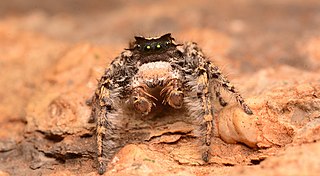
Phidippus carolinensis is a species of jumping spider in the family Salticidae. It is found in the United States and Mexico.

Habronattus carolinensis is a species of jumping spider in the family Salticidae. It is found in the United States and Canada?.
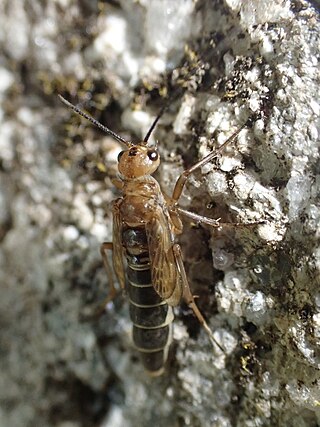
Brachypanorpa is a genus of scorpionflies in the family Panorpodidae. There are about five described species in Brachypanorpa.
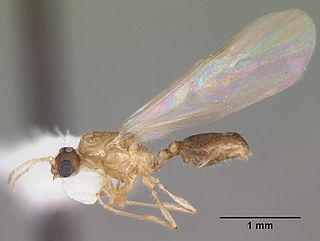
Solenopsis carolinensis, the thief ant, is a species of ant in the family Formicidae.
Echthodopa is a genus of robber flies in the family Asilidae. There are at least four described species in Echthodopa.
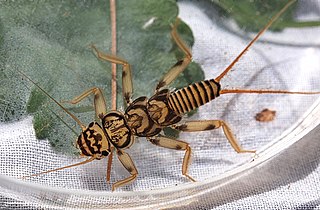
Acroneuria carolinensis, the Carolina stone, is a species of common stonefly in the family Perlidae. It is found in North America.
Brachypanorpa carolinensis, the short-nosed scorpionfly, is a species of scorpionfly in the family Panorpodidae. It is found in eastern North America.















